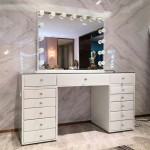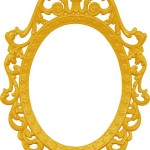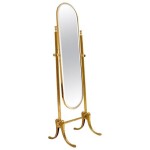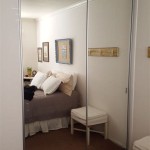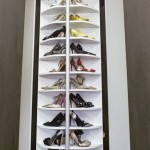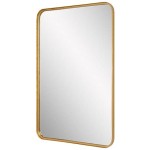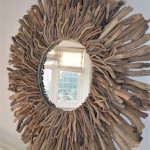Antique Full-Length Mirrors: A Timeless Reflection of Style and History
Antique full-length mirrors are more than reflective surfaces; they are artifacts that embody historical design trends, craftsmanship, and societal values. These mirrors offer a glimpse into the past, providing insight into the eras during which they were created. Understanding the characteristics, origins, and preservation of antique full-length mirrors allows collectors and enthusiasts to appreciate their enduring appeal and intrinsic value.
The concept of a full-length mirror, allowing a complete view of one's attire and appearance, evolved alongside advancements in glassmaking and mirror production techniques. Prior to the 17th century, mirrors were small, often made from polished metal, and highly valued. The development of large-scale glass production in Venice and later in France revolutionized mirror manufacturing, paving the way for larger, more affordable mirrors. This accessibility contributed to the rising popularity of full-length mirrors in the homes of the wealthy.
An antique full-length mirror serves as a visual record of its period, reflecting the prevailing decorative styles and manufacturing capabilities of its time. From the elaborate carvings of the Baroque era to the clean lines of the Art Deco movement, these mirrors offer a tangible connection to design history.
Identifying Key Features: Age, Style, and Materials
Determining the age and authenticity of an antique full-length mirror requires careful examination of its features. Several key indicators can assist in this process, including the mirror's glass, frame, backing, and overall construction. It's imperative to understand the stylistic conventions of different periods to accurately attribute a date range to the piece.
The glass itself provides clues to the mirror's age. Early mirror glass, produced before the advent of modern manufacturing techniques, is often characterized by imperfections, waviness, or slight discoloration. These flaws are the result of the manufacturing processes of the time. Examining the glass for silvering issues can also be helpful. Older mirrors were silvered using a different process than modern mirrors, and the silvering may show signs of wear, spotting, or darkening around the edges. This silvering process involved using an amalgam of tin and mercury, a technique that resulted in a softer, less reflective surface than modern mirrors.
The frame is another crucial element in identifying an antique full-length mirror. The style of the frame, the materials used, and the craftsmanship evident in its construction can all provide valuable insights into the mirror's origins. For example, a mirror with an ornate gilded frame adorned with carvings of cherubs and foliage would likely date from the 18th or early 19th century, reflecting the Baroque or Rococo styles. Conversely, a mirror with a simple, geometric wooden frame might suggest a Mid-Century Modern origin.
The wood used to construct the frame can also point to a specific period or region. Mahogany, walnut, and oak were commonly used in antique furniture making, and the type of wood can help narrow down the timeframe. Furthermore, the construction techniques employed in the frame's creation can reveal clues. Hand-cut dovetails, for instance, are indicative of older, handcrafted pieces. Evidence of machine-made joinery suggests a later date of manufacture.
The backing of the mirror, often made of wood or another sturdy material, should also be scrutinized. The type of wood used for the backing, as well as any markings, labels, or stamps present, can offer clues to the mirror's manufacturer or place of origin. In some cases, the backing may have been replaced over time, which can complicate the identification process. Examining the hardware used to secure the mirror glass to the frame can also provide clues. Older screws and nails often differ in appearance from modern fasteners, and their presence can support the mirror's claimed age.
Finally, the overall construction and condition of the mirror should be assessed. Signs of wear and tear, such as scratches, chips, or repairs, can be expected in antique pieces. However, excessive damage or evidence of poor-quality repairs may detract from the mirror's value. It's essential to carefully evaluate the mirror's condition and determine whether any restoration work has been performed. Professional restoration can enhance the mirror's appearance and functionality, but it's crucial to ensure that any repairs are done in a manner that preserves the mirror's original character and integrity.
Exploring Historical Styles and Influences
Antique full-length mirrors reflect the prevailing design trends and artistic influences of their respective eras. Understanding these historical styles is crucial for accurately identifying and appreciating the aesthetic qualities of these mirrors. Styles vary widely, each reflecting the cultural and artistic values of its time.
The Baroque period (approximately 1600-1750) was characterized by grandeur, opulence, and elaborate ornamentation. Mirrors from this era often feature heavily gilded frames adorned with intricate carvings of scrolls, foliage, and mythological figures. The Rococo style (approximately 1730-1770) built upon the Baroque, emphasizing even greater ornamentation and asymmetry. Rococo mirrors frequently incorporate shell motifs, floral garlands, and delicate curves.
The Neoclassical style (approximately 1760-1840) represented a reaction against the extravagance of the Baroque and Rococo periods. Neoclassical mirrors feature simpler, more symmetrical designs, often inspired by ancient Greek and Roman art. Common motifs include columns, pediments, and geometric patterns. Frames are typically made of mahogany or other fine woods and may be adorned with restrained carvings or gilded accents.
The Victorian era (1837-1901) encompassed a wide range of styles, reflecting the rapid technological advancements and evolving social tastes of the time. Victorian mirrors can be found in a variety of materials, including mahogany, walnut, and rosewood. Frames may be elaborately carved, inlaid with mother-of-pearl, or decorated with gilt accents. The Aesthetic Movement, a sub-style within the Victorian era, emphasized beauty and craftsmanship, often incorporating natural motifs and influences from Japanese art.
The Art Nouveau period (approximately 1890-1910) was characterized by its organic forms, flowing lines, and emphasis on natural motifs. Art Nouveau mirrors often feature asymmetrical designs and incorporate elements such as flowers, vines, and stylized female figures. Materials commonly used include wood, metal, and glass, often combined in innovative ways.
The Art Deco period (approximately 1920-1939) represented a departure from the ornate styles of the past, embracing clean lines, geometric shapes, and modern materials. Art Deco mirrors often feature streamlined designs and incorporate elements such as chrome, glass, and lacquer. Frames may be adorned with geometric patterns, stylized motifs, or mirrored panels.
Understanding these historical styles allows collectors and enthusiasts to appreciate the unique aesthetic qualities of antique full-length mirrors and to identify the periods and influences that shaped their design. By examining the frame, glass, and overall construction of a mirror, it's possible to gain a deeper understanding of its artistic and historical significance.
Care and Preservation of Antique Mirrors
Antique full-length mirrors are delicate objects that require careful handling and maintenance to ensure their long-term preservation. Improper care can lead to damage, deterioration, and loss of value. Therefore, it's essential to follow best practices for cleaning, storage, and repair.
Cleaning antique mirrors should be approached with caution. Avoid using harsh chemicals or abrasive cleaners, as these can damage the glass and frame. Instead, use a soft, damp cloth to gently wipe the surface of the glass. A mild solution of water and vinegar can be used to remove stubborn dirt or grime. Be sure to dry the glass thoroughly after cleaning to prevent water spots or streaking. Never spray cleaning solutions directly onto the mirror, as this can cause the liquid to seep behind the glass and damage the silvering.
The frame of an antique mirror should be cleaned separately, using appropriate methods for the specific material. For wooden frames, a soft brush or cloth can be used to remove dust and debris. Avoid using liquid cleaners on wooden frames, as these can damage the finish. For gilded frames, a dry brush or a specialized gilding cleaner can be used to remove dust and tarnish. Metal frames should be cleaned with a soft cloth and a metal polish designed for the specific metal. Always test any cleaning product on an inconspicuous area of the frame before applying it to the entire surface.
Proper storage is essential for preserving antique full-length mirrors. Avoid storing mirrors in areas with high humidity or extreme temperatures, as these conditions can cause damage to the glass, frame, and silvering. Mirrors should be stored in a dry, well-ventilated area, away from direct sunlight. If a mirror must be stored for an extended period, it should be wrapped in a protective material, such as acid-free paper or bubble wrap. It's crucial to handle mirrors with care during storage and transportation to prevent breakage.
Repairs to antique full-length mirrors should be undertaken by experienced professionals. Attempting to repair a mirror yourself can often result in further damage. Professional restorers have the knowledge and skills necessary to repair cracked glass, replace damaged silvering, and restore damaged frames. It's essential to choose a restorer who specializes in antique mirrors and who understands the importance of preserving the mirror's original character and integrity. Any repairs should be done using materials and techniques that are compatible with the mirror's original construction.
Regular inspection is crucial for identifying potential problems early on. Examine the mirror for signs of damage, such as cracks, chips, or loose frame joints. Address any issues promptly to prevent them from worsening. Protect antique mirrors from physical damage by positioning them in areas where they are unlikely to be bumped or knocked over. By following these care and preservation guidelines, collectors and enthusiasts can ensure that their antique full-length mirrors remain beautiful and valuable for generations to come.

Oversized Full Length Mirror Antique Gold Handmade French Era Inspired 19th Century Design Stand Alone Show Stopper

One Allium Way Antique Full Length Mirror Floor

Antique Mirror Home Decor Wall Living Room Aesthetic Full Length 28x70 Gold Gilded

Large Classic Baroque Mirror 17th Century Antique Italian Silver Leaf Made In Italy Full Length Victorian Home Style Item 8064 Sweden

Gilt Full Length Mirror Dressing Antique Long Tall Portrait Overmantel Overmantle Pier Wall Convex

Antique Full Length Bevelled Keyhole Shaped Standing Mirror

Extra Large Silver Full Length Mirror Flora Furniture

Large Silver Gilt Antique Style Wall Mounted Mirror Arched 6ft4 X 4ft6 192x134cm

22 X 64 Vintage Gold Full Length Mirror Antique Floor With Ornate Carvings Victorian Design French Baroque For Living Room Or Bedroom By Barnyard Designs Com

Antiques Atlas Antique Mirror Cheval Large Vanity Full Length
